The AMD Threadripper 2 CPU Review: The 24-Core 2970WX and 12-Core 2920X Tested
by Ian Cutress on October 29, 2018 9:00 AM ESTGaming: Grand Theft Auto V
The highly anticipated iteration of the Grand Theft Auto franchise hit the shelves on April 14th 2015, with both AMD and NVIDIA in tow to help optimize the title. GTA doesn’t provide graphical presets, but opens up the options to users and extends the boundaries by pushing even the hardest systems to the limit using Rockstar’s Advanced Game Engine under DirectX 11. Whether the user is flying high in the mountains with long draw distances or dealing with assorted trash in the city, when cranked up to maximum it creates stunning visuals but hard work for both the CPU and the GPU.
For our test we have scripted a version of the in-game benchmark. The in-game benchmark consists of five scenarios: four short panning shots with varying lighting and weather effects, and a fifth action sequence that lasts around 90 seconds. We use only the final part of the benchmark, which combines a flight scene in a jet followed by an inner city drive-by through several intersections followed by ramming a tanker that explodes, causing other cars to explode as well. This is a mix of distance rendering followed by a detailed near-rendering action sequence, and the title thankfully spits out frame time data.
| AnandTech CPU Gaming 2019 Game List | ||||||||
| Game | Genre | Release Date | API | IGP | Low | Med | High | |
| Grand Theft Auto V | Open World | Apr 2015 |
DX11 | 720p Low |
1080p High |
1440p Very High |
4K Ultra |
|
There are no presets for the graphics options on GTA, allowing the user to adjust options such as population density and distance scaling on sliders, but others such as texture/shadow/shader/water quality from Low to Very High. Other options include MSAA, soft shadows, post effects, shadow resolution and extended draw distance options. There is a handy option at the top which shows how much video memory the options are expected to consume, with obvious repercussions if a user requests more video memory than is present on the card (although there’s no obvious indication if you have a low end GPU with lots of GPU memory, like an R7 240 4GB).
All of our benchmark results can also be found in our benchmark engine, Bench.
| Game | IGP | Low | Medium | High |
| Average FPS | 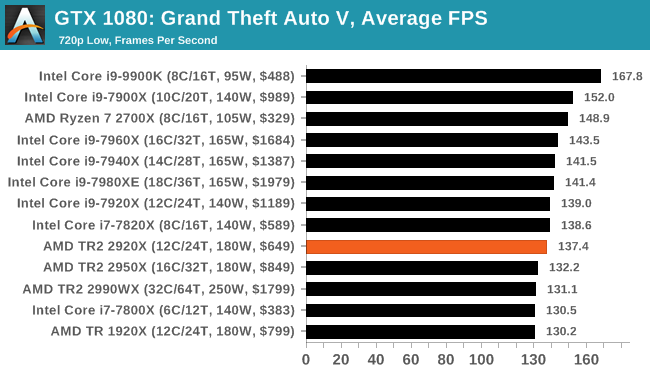 |
 |
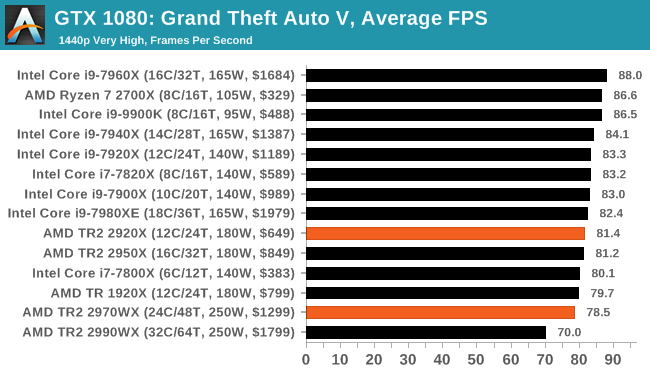 |
 |
| 95th Percentile | 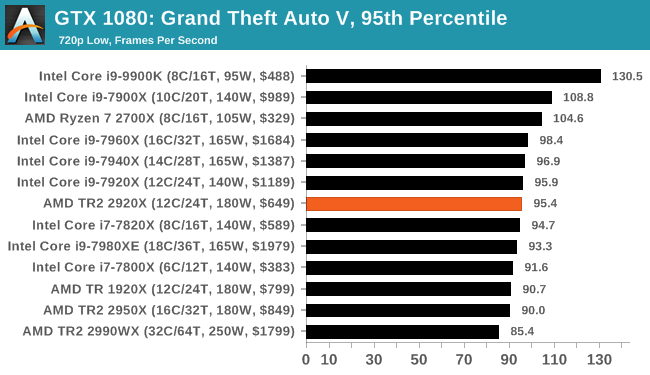 |
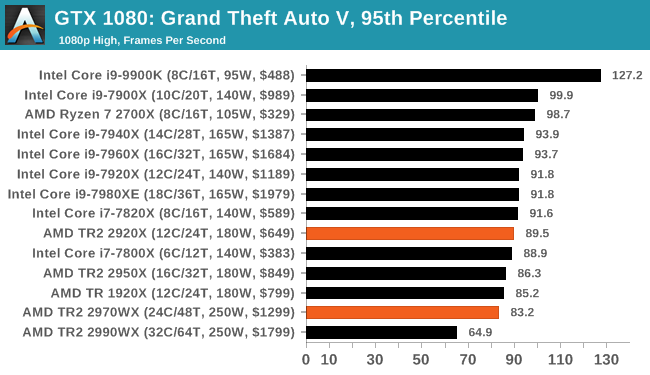 |
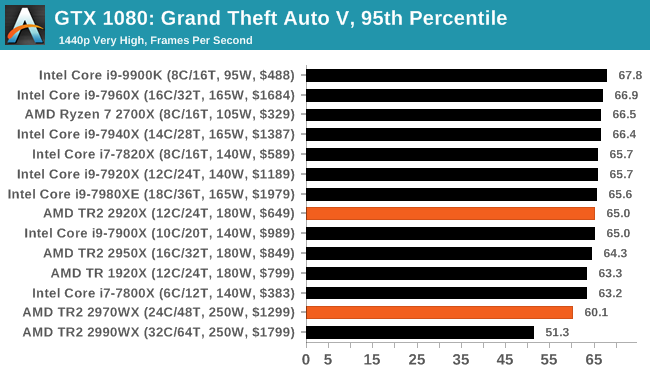 |
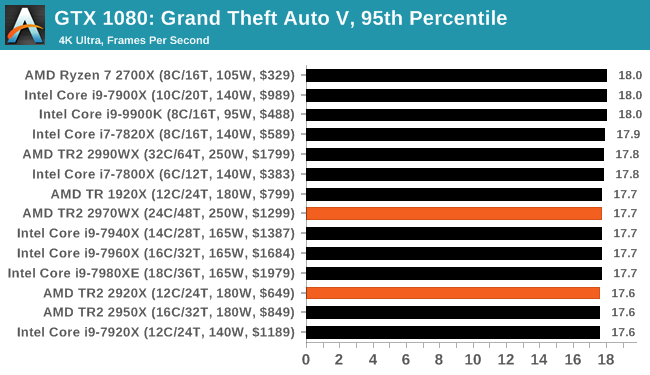 |












69 Comments
View All Comments
schujj07 - Monday, October 29, 2018 - link
You would be far to limited with RAM to run 60 VMs on that system. I've got 80 on dual Dell 7425's with dual 24 Core Epycs and 512GB RAM and I'm already getting RAM limited.Again I wouldn't install ESXi on these. Use Win 10 and Workstation for your test/dev and you will have a more agile system. If you don't need it for testing that day you still have Windows. FYI I'm VMware Admin.
Ratman6161 - Monday, October 29, 2018 - link
All depends...in my home lab environment (which lets me test things at will and do whatever I want as opposed to at work where even the lab is more locked down) . For me, the Threadrippers would be great...but extreme overkill. I actually use old FX8320's which I bought when they were dirt cheap and DDR3 RAM was cheap too. The free version of ESXi works fine for me too. For my purposes the threadrippers would be really cool but more expensive than they would be worth.Icehawk - Monday, October 29, 2018 - link
I would love one of these high cores boxes for our test lab, using W10 and VM on my desktop is very limiting for me (work rig is 7700 & 32gb) - one of these would let me put plenty of resources onboard. Currently my lab runs off a G6 Dell server which is totally fine but if I could get myself a new, personal, lab I'd want a TR rig since it can host a lot more RAM than Intel's option.odrade - Tuesday, October 30, 2018 - link
Hi I completely agree with you.With security enhancement moving to sandbox/VM (Application Guard, Sandboxed Defender in 19H1) virtualization scenario will be more prevalent beyond developper or test scenarios.
One major disappointment is that after 12+ months since GA there is no support for nested virtualization for TR/TR2 ?, Ryzen ? Epyc ?.
This issue seems to be general and not limited to hyper-v (KVM, etc..).
This is strange since EPYC made is way through Azure or Oracle Cloud catalog.
During Ignite 2018 there was a demo with an EPYC box (VM or Server).
Regards G.
GreenReaper - Wednesday, October 31, 2018 - link
You could ask for HyperV over here:https://windowsserver.uservoice.com/forums/295047-...
But such features are often buggy in their initial implementations:
http://www.os2museum.com/wp/vme-broken-on-amd-ryze...
https://www.reddit.com/r/Amd/comments/8ljgph/has_t...
It wouldn't surprise me if they ran into too many problems to want to push out a solution. And Intel has had issues here too - most recently L1 Terminal Fault relating to EPT:
https://www.redhat.com/en/blog/understanding-l1-te...
If people buy enough of them, and there is a performance benefit or it otherwise becomes a feature differentiator, support will doubtless be developed. Chicken and egg, I know.
odrade - Monday, November 5, 2018 - link
Hi,Thanks four your inputs.
This feature is handy if you want to build advanced lab scenarios while preserving your work environment or avoid the hassle to use dual boot.
Maybe this feature will be enabled with the 2019 Epyc / TR iteration.
And if the the socket and compatibility promises is kept by AMD refreshing
my setup will do it and put those extra pcie lanes to use (upgrading storage as well).
At least the 7mm process will help to kept the power compatibility in line.
Regards G.
Blindsay - Monday, October 29, 2018 - link
For the chart on the last page, the "12-core Battle" it would be interesting to see a "similar price battle" of like the 9900k vs 7820X vs 2920X. I suspect the 9900k would hold up rather well especially once it returns to its SRPmapesdhs - Monday, October 29, 2018 - link
A battle for what? If it's gaming, get the far cheaper 2700X and using the difference to buy a better GPU, giving better gaming results by default (some niche cases at 1080p, but in general the 9900K is a poor value option for gaming, except for those who've gone the NPC route into high refresh displays from which there's no way back, ironic now NVIDIA has decided to move backwards to sub-60Hz 1080p with RTX).Blindsay - Monday, October 29, 2018 - link
Definitely not for gaming lol. It is for a home server (unraid)PeachNCream - Tuesday, October 30, 2018 - link
That's a lot of compute for a home server. Home servers (outside of those used for the development of professional skills or to test software outside of a setting where there are office usage policies) serve very limited useful purposes. They're mainly a solution looking for a problem or just fun to mess around with. I have an old C2D E8400-powered desktop PC with 8GB of RAM that I just recently put online as a local file, media, and internal web server connected via a cheap TPLink PCI (non-e) wifi card. There's nothing that the kids and I have done to it yet that brings it anywhere close to its knees. Even streaming videos from it to three other systems at once is a non-issue and all of those files are stored on a single 1TB 5400 RPM 2.5 inch mechanical HDD. TR is extreme overkill for a toy server at home. Literally any old scavenged desktop or laptop can act as a home server.